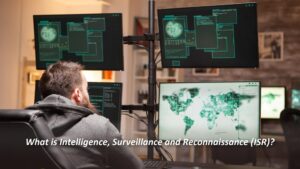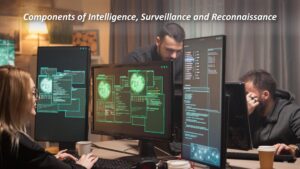Intelligence, surveillance and reconnaissance (ISR) play a crucial role in every military operation. They offer policymakers and operatives a comprehensive understanding of the conditions on the battlefield, in the sky, at sea, in space, and within cyberspace.
Specialists in ISR monitor and track the activities of adversaries to gather valuable information. The effectiveness of achieving mission objectives is significantly amplified by maintaining a proactive approach that anticipates and outmaneuvers the opposing forces.
Battlefield leaders utilize ISR capabilities to collect pertinent information for tactical planning. This enables them to intercept communications, observe movements, and formulate strategies, plans, and resource allocations.
What is Intelligence, Surveillance and Reconnaissance (ISR)?

ISR is frequently utilized in various military applications. It encompasses the coordinated collection, analysis, and distribution of precise, pertinent, and timely information and intelligence to aid in the decision-making process of a commander.
ISR systems have the capability to gather data from a diverse array of sources, such as electronic communications, optical devices, radar technology, and infrared imaging. This data is collected through various means, including satellites, sensors, unmanned aircraft, aviation systems, specialized equipment located on the ground, at sea, or in space, as well as intelligence personnel.
The provision of precise ISR information plays a crucial role in delivering top-notch intelligence on adversary risks, thereby augmenting the efficacy of military endeavors. The ever-evolving technological advancements have further amplified the need for ISR capacities in recent times.
Also Read : A Beginner’s Guide to Genomic Sequencing: Everything You Need to Know!
Components of Intelligence, Surveillance and Reconnaissance

ISR consists of a series of interconnected components that are specifically designed to gather, analyze, and distribute information to aid in the process of making informed decisions. The primary components encompassed within intelligence, surveillance and reconnaissance are as follows:
● Human Intelligence (HUMINT):
It refers to the gathering of intelligence by engaging with individuals. This process involves conducting interviews, debriefings, and establishing human connections to acquire firsthand information.
● Signals Intelligence (SIGINT):
SIGINT is the process of interpreting and analyzing various types of signals, such as communication signals, electronic emissions, and transmitted data. This practice aids in comprehending the communication and electronic environment.
● Imagery Intelligence (IMINT):
IMINT encompasses the acquisition and examination of visual data from diverse origins, including satellites, reconnaissance planes, or unmanned aerial vehicles (UAVs). Its primary objective is to furnish intelligence-driven imagery of the operational surroundings.
● Geospatial Intelligence (GEOINT):
GEOINT involves the integration of spatial and geographic data with various other intelligence fields. This encompasses tasks such as mapping, analysis of terrains, and the utilization of geographic information systems (GIS) to augment one’s understanding of a particular situation.
● Measurement and Signature Intelligence (MASINT):
MASINT involves the gathering and examination of information obtained from observable characteristics, including radar patterns, infrared emissions, and nuclear readings. This field offers distinct technical intelligence that goes beyond conventional approaches.
● Unmanned Aerial Vehicles (UAVs):
UAVs, also known as drones, are airborne devices that are equipped with sensors and cameras used for gathering information through reconnaissance and surveillance purposes. These technological advancements are vital in acquiring real-time data without endangering human lives.
● Satellite Systems:
Satellites are employed for visual representation and signal gathering. They provide a worldwide viewpoint and have the capability to collect information in different wavelengths, aiding in fulfilling strategic and operational intelligence needs.
Applications of Intelligence, Surveillance and Reconnaissance
ISRs have wide-ranging applications across various domains due to their capabilities in collecting, analyzing, and disseminating critical information. Some key applications include:
Military Operations:
Strategic Intelligence: ISR assists military decision-makers by offering strategic intelligence, which encompasses details regarding the capabilities, intentions, and possible hazards posed by enemy forces.
Tactical Reconnaissance: ISR assets, such as UAVs and satellites, are utilized to conduct real-time intelligence gathering to assist ground operations, identify targets, and evaluate the battlefield situation.
Border Security:
ISR technologies are utilized for the surveillance and safeguarding of national boundaries, aiding authorities in the identification and prevention of unlawful border crossings, smuggling activities, and other threats pertaining to border security.
Law Enforcement:
Intelligence, surveillance and reconnaissance provide assistance to law enforcement agencies in conducting surveillance and carrying out criminal investigations. Its application extends to the monitoring of areas with high crime rates, tracking individuals suspected of unlawful activities, and gathering valuable evidence.
Maritime Surveillance:
ISR is employed to oversee maritime operations, monitor vessel movements, and deter unlawful activities like piracy, contraband trafficking, and unauthorized fishing.
Environmental Monitoring:
Satellites that possess intelligence, surveillance and reconnaissance capabilities play a crucial role in environmental monitoring as they gather information about climate change, deforestation, pollution, and various ecological factors.
Cybersecurity:
In the realm of digital technology, ISR involves the tasks of monitoring and analyzing cyber threats, identifying security weaknesses, and gathering intelligence related to potential cyber-attacks.
Space Surveillance:
ISR is also utilized in space to observe and monitor objects present in the Earth’s orbit, guaranteeing the protection of satellites and identifying potential hazards originating from space.
Final Thoughts
The multifaceted field of intelligence, surveillance and reconnaissance encompasses a diverse array of components and technologies. From human intelligence (HUMINT) to signals intelligence (SIGINT), the ISR framework is intricately woven into military operations, border security, law enforcement, disaster response, and environmental monitoring. Moreover, the continuous evolution of technology, marked by unmanned aerial vehicles (UAVs), satellite systems, and advanced analytics, has propelled ISR into a new era of efficiency and effectiveness. Those involved in surveillance and reconnaissance training, particularly within the surveillance and reconnaissance air force, play a pivotal role in honing the skills necessary to navigate the complexities of gathering and analyzing critical information.
Looking forward, the future of intelligence, surveillance and reconnaissance promises even greater integration of artificial intelligence, machine learning, and emerging technologies, ushering in an era of enhanced predictive capabilities and real-time decision support. As we continue to unlock new possibilities, it is imperative to approach the advancement of ISR with a commitment to ethical standards, ensuring that the pursuit of security is harmonized with the preservation of fundamental values and human rights.




